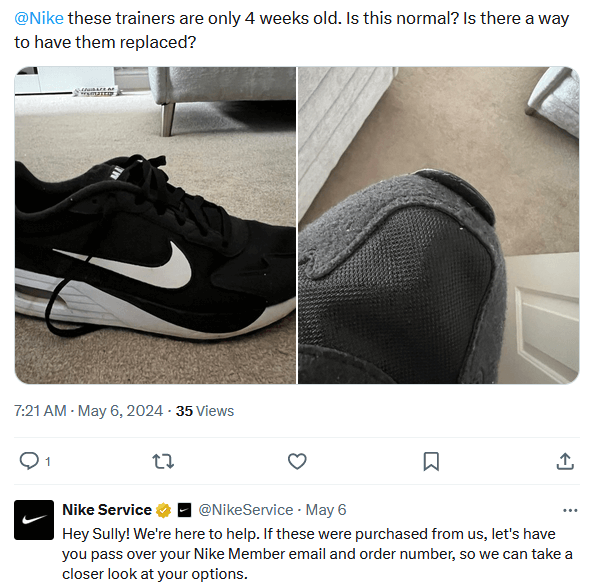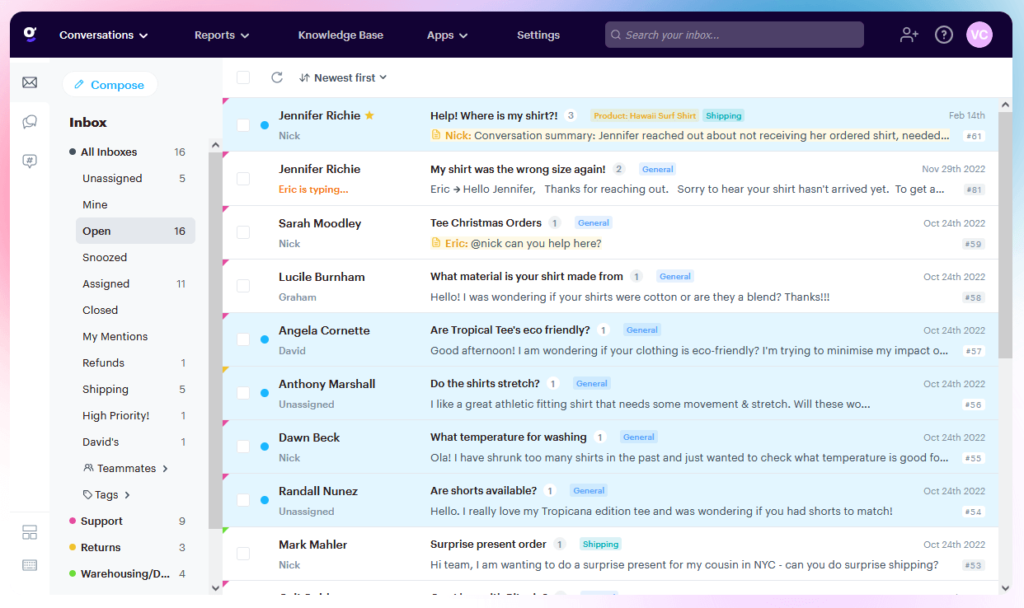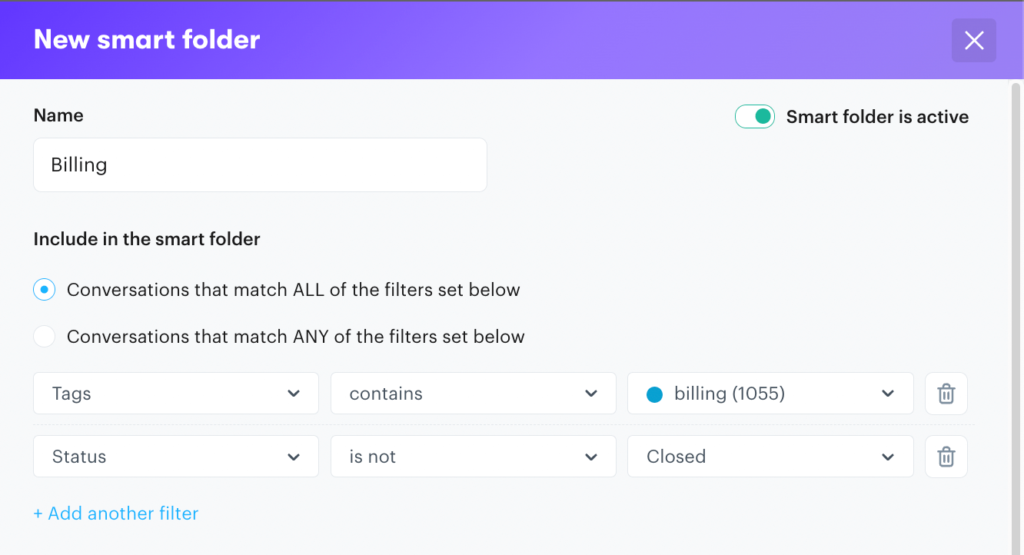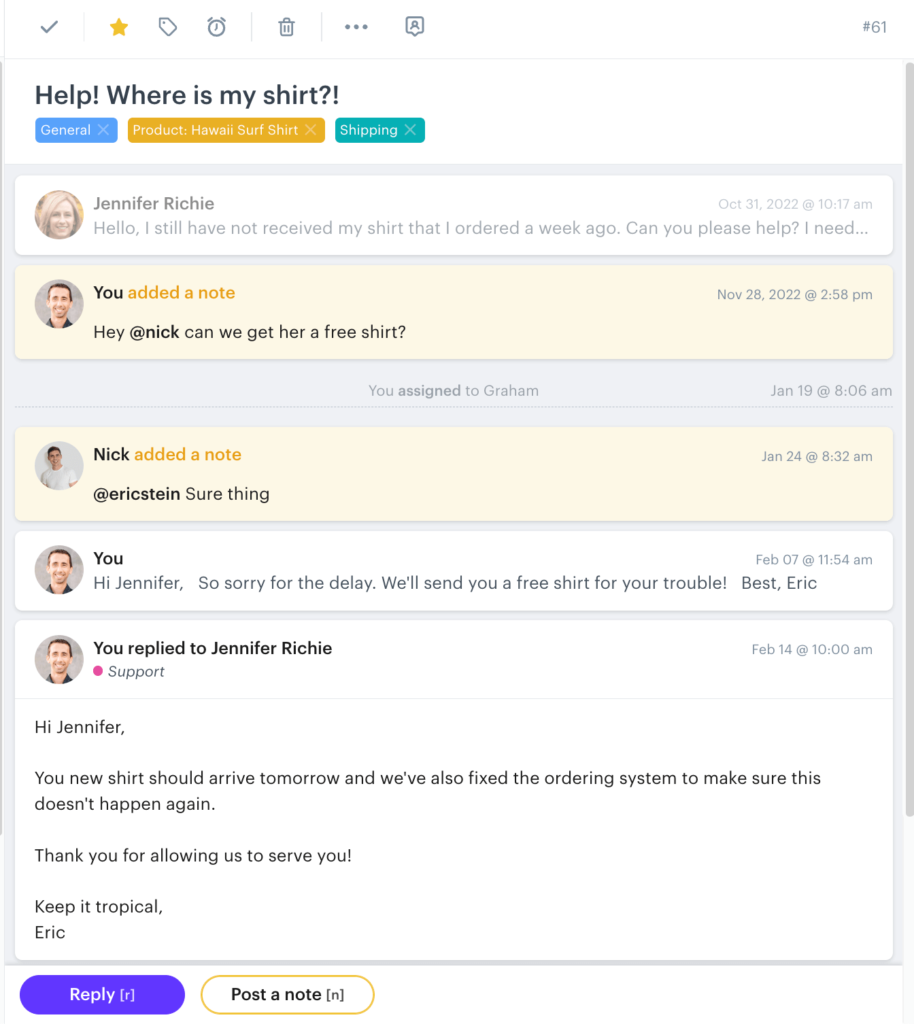Have you ever encountered a customer complaint that irreversibly damaged their relationship with your company?
Sometimes there’s nothing you can do to turn things around with an unhappy buyer. However, the above scenario can often be prevented, and in some cases a complaint can be turned into a positive experience that increases customer trust.
Often, what makes the difference is whether you know how to handle customer complaints with style. So let’s talk about how to increase your success rate.
Why the Way You Handle Customer Complaints Matters
When you’re in the trenches of customer service, learning how to handle customer complaints can feel like a daily battle. But it’s important to realize that your approach to these situations is more than just damage control – it’s an opportunity.
Every unhappy customer is giving you a chance to turn their experience around. With the right approach, you can:
- Increase customer satisfaction. A swift, empathetic response to a complaint can transform an unhappy customer into a satisfied one. Satisfaction often leads to repeat business and more revenue.
- Enhance customer loyalty. The way you handle issues affects customer loyalty. Customers remember the service more than the product. Show genuine care, and they’ll be more likely to stick around.
By addressing complaints effectively, you’re not just putting out fires. You’re building a reputation, showing what kind of company you are.

People talk, and in the age of social media, a positive view of how you’ve handled an issue can spread quickly. This same tactic helps to ward off negative viral effects that could harm your business.
6 Steps for How To Handle Customer Complaints
It’s one thing to understand that how you handle customer complaints matters a lot. It’s another to do so effectively and repeatedly.
With that in mind, let’s dive deeper into how to handle even the most difficult of complaints!
Step 1: Establish a System for Tracking Customer Complaints with Groove
You can’t learn how to handle customer complaints well until you have the tools in place to support that process. At a minimum, you’ll need to:
- Receive customer complaints via a variety of channels, such as email and live chat.
- Collect them into one place where they can be prioritized, categorized, and addressed promptly by support agents.
Enter Groove:

Groove is an all-in-one platform for providing quality customer service. It keeps track of all your feedback (positive and negative) in one spot, so nothing slips through the cracks.
With Groove, you’ll have a range of tools that will help to prevent many complaints. For instance, live chat and a knowledge base help you provide support when and how customers need it.
When you do get complaints, though, Groove makes it easy to organize them. You can categorize each complaint as it comes in, and even label them by issue type or urgency:

Then you can:
- Prioritize: Sort complaints by urgency or impact.
- Assign: Hand tickets off to the right team member.
- Monitor: Keep an eye on the status of each issue.
Once you have all your complaints in Groove, you can start tackling them per the following steps. Groove makes the rest of the complaint management process much easier than trying to address messages through a traditional platform like Gmail or Outlook.
Step 2: Provide a Fast Initial Response
Your customers need to know you’re on it– and fast! Aim for a response time that impresses. This could be anywhere from a few minutes to within 24 hours, depending on your business.
Speed is key, but so is acknowledgment. A personalized email might not be doable at lightning speed, which is where canned responses come in handy. A well-crafted canned response can be a lifesaver, letting your customer know that their issue has been received and will be dealt with soon.
If you’re wondering how to handle customer complaints quickly, we’d recommend:
- Setting up automation. Use tools to trigger an immediate email or message when a complaint is received. Don’t leave your customer waiting.
- Draft thoughtful canned responses. Keep them concise but friendly, and assure the customer that their complaint is being looked into.
- Empower your team. Make sure your customer support team has the right responses at hand, and give them freedom to adapt as necessary.
- Follow-up quickly. Once the initial acknowledgment is out, work on a more personalized follow-up as soon as possible.
Remember that your goal is to make the customer feel important and listened to. First impressions go a long way towards giving that impression.
Step 3: Use Effective Complaint Resolution Techniques
After the initial contact is made, it’s important to remember that you’re not just fixing a problem. You’re also building trust. It’s time to show that your support experience isn’t just good – it’s stellar.

So when you’re hit with a customer complaint, roll up your sleeves and get ready to turn that frown upside down. You’ll need to:
- Listen and empathize. Just like a good friend, give your customer the floor. Let them air out their woes without interruption. Remember, a listening ear is your first tool in the kit.
- Adjust to the customer’s communication style. Are they a chatterbox or a straight-shooter? Tailor your conversation to fit their style. Try to intuit if they want a quick fix or a detailed action plan.
- Empower the customer. Assure your customers that they have power in the interaction too – “You’ve got great taste, and we want to make this right for you.”
- Diagnose like a pro. Don’t jump the gun when it comes to finding a solution. It’s better to take your time and solve it on the first try than to present the first idea that comes to mind but doesn’t work.
- Present a solution. The solution should directly tackle the problem and put the customer at ease. If you can’t accomplish exactly what they want, try to establish a compromise or present a consolation offer.
Last but not least, remember that speed continues to matter throughout the entire interaction. The quicker your responses are, the better you can serve the customer and the faster you can move on to the next complaint.
Step 4: Provide Your Customer Service Team with Training and Resources
Doing the above isn’t always simple. So it’s best not to hand your support agents a list of tips and hope for the best.
Instead, you can support their (and your business’) success by:
- Sharpening customer service skills: Equip your team with top-notch customer service training. Focus on patience, empathy, and maintaining positivity. Role-playing scenarios can be a fun, interactive way to prepare your team for real-life complaints.
- Building a comprehensive knowledge base. Your team should know your products or services inside out. A robust knowledge base helps them provide accurate information and solutions quickly. Plus, this is easy to set up using Groove.
- Putting quality control measures in place. Even the best support team requires oversight. Fortunately, with Groove you get easy access to key metrics that let you know how your team is performing, and whether your customers are receiving the best service possible.
Teach your team how to handle customer complaints, and they’ll be well equipped to deal with a wide variety of situations.
Step 5: Invest in Post-Complaint Customer Relationships
Once you’ve handled a customer’s complaint, don’t consider the case closed. You’ve got a great opportunity to turn a tough situation into a loyal customer relationship.
Instead, you can follow up by:
- Shooting an email or a text a few days after the resolution. Ask your customer if everything’s settled to their satisfaction. This lets them know you care beyond the sale.
- If you’re keen on feedback, send a short survey. Keep it simple, but encourage honest opinions about how you handled the situation.
A few other tips for making the best of customer complaints include:
- Offer an unhappy customer a discount on their next purchase. This can sway their decision to stick around.
- Publicly acknowledge any mistake if the complaint was made through social media, and outline your steps to fix it. Transparency breeds trust.
- Regularly review online reviews and address any negative patterns in your service before more complaints roll in.
- Engage with customers on social media. Don’t just address service issues. Share regular updates and a bit of fun. This builds community and shows that you’re more than just a business.
- Remember to appreciate and thank customers who took the time to leave positive reviews or feedback. It can encourage others to do the same.
Every business makes mistakes, and every product or service has its flaws. Being honest and transparent about these issues with your customer base will be more beneficial than trying to hide them.
Step 6: Learn from Complaints
Once you’ve addressed the immediate customer complaint, it’s time to circle back and extract long-term value from the situation.
You can think of customer complaints as a goldmine for insights. They’re direct feedback on how you can improve your products or services.
So periodically, you’ll want to take a look at the common customer complaints you’re receiving. Are any patterns emerging? You might notice trends across various channels, be it direct feedback, customer satisfaction surveys, or social media comments.
To make this easier, you can have support agents track and categorize complaint types:
| Complaint Type | Frequency | Notes |
| Product Quality | 10 | Defective items |
| Customer Service | 5 | Long wait times |
| Shipping Issues | 8 | Delays, damages |
You can also engage directly with negative feedback. Once a customer’s concern is resolved (or if you can’t resolve it), ask follow-up questions to dig deeper into the issues. This also shows customers that you’re serious about improving, even if you can’t make them 100% happy right now.
After that, it’s time to implement changes. Based on the feedback you receive, you may need to revise your quality control processes or employee training programs. If a product gets consistent negative remarks, on the other hand, it might be time to revisit its design or features.
Turning Complaints into Customer Service Wins
Every customer complaint is an opportunity to go above and beyond. You’ll never eliminate complaints, but you can make the best of them.
When deciding how to handle customer complaints for your business, remember to:
- Listen and Understand. Practice active listening, and confirm that you hear and understand the customer.
- Stay Zen. Keep it cool, stay polite, and focus on finding out what you need in order to present a solution.
- Thank the customer. It shows that you value their input, and it can defuse a tense situation.
- Apologize gracefully. Even if the customer is confused or unreasonable, empathize with their frustration.
- Present a solution. Ask the right questions to get to the heart of the issue, then whip out your problem-solving cape and offer an effective fix.
- Follow up. After the storm has passed, check back in. A simple email or survey to gauge their happiness post-resolution can work wonders for customer retention and turning negative feedback into loyal cheerleaders.
- Learn from negative feedback. Each complaint is actually a goldmine, letting you know how you can better serve customers in the future.
If you need a way to keep track of customer complaints and respond to them quickly, Groove can help! Support your customer service team by providing them with the tools they need to perform at their best.


